
Figure 1. A
single mod/con boiler supplying space heating and domestic hot water.
There are now at least 12 companies offering modulating/condensing (mod/con) boilers for residential/light commercial applications in North America. More offerings are surely waiting in the wings. In the last five years, this category of boilers has gone from virtually non-existent (in North America) to being a significant sector of the market.
Most of these newer boilers have two operating modes: Space heating and domestic water heating (DHW). These modes are mutually exclusive from the standpoint of temperature.
When the boiler operates in space heating mode, its supply temperature is calculated based on the corresponding outdoor temperature (e.g., outdoor reset control). The warmer it gets outside, the lower the supply temperature from the boiler. Lower supply temperatures encourage flue gas condensation and boost thermal efficiency.
During a call for domestic water heating the outdoor temperature is ignored. Instead, the boiler “targets” a fixed setpoint temperature at which the heat exchanger of the indirect water heater is supplied. This is typically in the range of 160°F to 180°. The higher supply temperature is often necessary to deliver the full output of the boiler through the heat exchanger in the domestic hot water subsystem.
Since the boiler cannot produce both temperatures simultaneously, the domestic hot water tank is typically treated as a priority load. Space heating is temporarily suspended during a call for domestic water heating. A typical piping diagram for this type of system is shown in Figure 1.
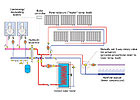
Figure 2.
Use of a manually set mixing valve to produce lower water temperature for
radiant panels.
Proportional Reset Control
Although this concept works well in applications where the space heating system requires a single supply water temperature, there are times when multiple water temperatures are needed. An example would be when the boiler supplies panel radiators as well as slab-type radiant floor heating in the same building.One approach that takes advantage of the controls already built into these boilers is called proportional reset control. It uses a manually set (non-thermostatic) mixing valve to provide the lower water temperature as illustrated in the schematic of Figure 2.
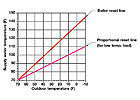
Figure 3.
Proportional reset relationship between boiler reset line and reset line
produced by manually set mixing valve.
A "Dumb" Device
When the “hot” stream entering a fixed-setting mixing device is reset, the temperature of the mixed stream leaving that device also tracks a reset line, one that’s shallower than the boiler reset line (Figure 3). This allows multiple fully reset supply temperatures to be created from a single boiler reset control.Designers should keep in mind that a fixed-setting mixing valve is a “dumb” device. It cannot react to changes in water temperature or flow rate. Zone circuits turning on or variations in the heat source temperature easily create such changes. It’s not a good idea to use proportional reset to supply a zoned distribution system, especially if that system operates with temperature setbacks or has high thermal mass. Such conditions can significantly lengthen the time it takes the distribution system to restabilize its supply temperature. The solution is simply to add a “brain” in the form of a motorized actuator for the mixing valve.
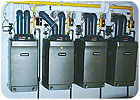
Figure 4.
Four wall-mounted mod/con boilers take up little space in mechanical room.
(Photo courtesy of John Goshulak.)
Multiple Benefits
Several manufacturers offer mod/con boilers with input rates from 50,000 to 399,000 Btuh. Two or more of these units can be combined into a multiple boiler system, which provides several benefits.- Relatively small and lightweight boilers are much easier to transport and place in comparison to a single large boiler. This is especially relevant in retrofit applications. Many mod/con boilers have the option of wall or floor mounting depending on available space (Figure 4).
- The turndown ratio of a multiple-modulating boiler system equals the turndown ratio of a single boiler multiplied by the number of those boilers. For example, a system consisting of four mod/con boilers, each with a turndown ratio of 5:1, would have a system turndown ratio of 20:1. With no oversizing, this boiler system could modulate and stage as necessary to track heating load down to 5% of its design value. This allows heat to be supplied at the same rate the load requires over the vast majority of operating hours, and minimizes the potential for short cycling.
- Failure of a single boiler does not stop heat flow to the load. The greater the number of boilers, the greater the load coverage should a boiler become inoperable.
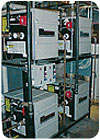
Figure 5.
Two-over-two stacking of mod/con boilers to reduce mechanical room floor space
requirement. Hydraulic separator shown between boilers and system piping.
(Photo courtesy of Heat Transfer Products.)
- Smaller boilers can be mounted on vertical racking, which conserves floor space in the mechanical room while still providing access for service and eventual replacement (Figure 5).
- All mod/con boilers can be sidewall vented - most using PVC or CPVC venting. This usually results in significant savings relative to chimney venting, especially in taller buildings.
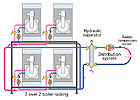

Figure 6.
Old chimney and new venting system for mod/con boilers at a Milwaukee school.
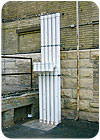
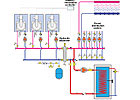
Figure 7.
Supply sensor placement for a multiple mod/con boiler system.
Piping Pointers
There are four crucial details when combining two or more mod/con boilers into a multiple boiler system: The piping and control configuration should allow flow through each boiler to be independently controlled. When a boiler is not firing, there should not be flow through it. Doing so simply uses the boiler’s heat exchanger and jacket as a heat-dissipating device. This is also an important detail when conventional on/off boilers are combined into a multiple boiler system.
Figure 8.
Dual mod/con boilers supplying load through a hydraulic separator. (Photo
courtesy of Dan Foley.)
Pump into the Boiler
Pump into the boiler. This forces the pressure inside the boiler’s heat exchanger to increase when the circulator is operating. Pumping away from the boiler causes a decrease in pressure within the heat exchanger. This can lead to steam flash inside the boiler’s heat exchanger. It’s a situation that must be avoided.Piping must provide consistent and adequate flow through operating boilers regardless of the system flow rate. The closely spaced tees or hydraulic separator shown in Figure 7 uncouple the flow dynamics of the boilers from those of the distribution system to ensure adequate boiler flow regardless of flow variations in the distribution system.
Place the boiler supply temperature sensor on the outlet side of the hydraulic separation point (Figure 7). This ensures that the staging/modulation controller receives the proper feedback on the water temperature supplied during domestic water heating as well as during space heating. It also accounts for any mixing within the closely spaced tees or hydraulic separator due to differences between boiler plant flow rate and system flow rate.
Baseload to Full Afterburner
Multiple mod/con boilers are an excellent choice for systems that have large demands for domestic hot water or snowmelting in addition to space heating. In these situations, a multiple mod/con boiler system can quickly go from a low “baseload” condition to a “full afterburner” mode when high demands are present.During a call for domestic water heating the boiler staging control targets a relatively high supply temperature, usually in the range of 180°to 200°. This provides high rates of heat transfer at the tank heat exchanger. In systems with multiple mod/con boilers, domestic water heating is treated as a priority load. All other heating loads are temporarily suspended, at least for a set time, while heat output is focused on the domestic hot water tank.
The number of boilers staged on for such a demand depends on the response of the system. A PID control loop in the boiler staging/modulation controller monitors how quickly the supply water temperature approaches the target setpoint. If the response is fast there is generally no need to stage on additional boilers. If the response is slow additional staging as well as upward modulation within the active boilers is likely.
When the DHW demand is satisfied (or times out of its priority setting) the staging controller returns to target temperature based on outdoor reset control. If the space heating load is low there may only be need to operate one boiler. The ability for both staging and modulation allows the boiler system to retain high efficiency over a wide range of output, and is a distinct advantage of a multiple mod/con boiler setup over a single larger mod/con boiler.
Tiny, Quiet, and Powerful
The physical size of several currently available modulating boilers relative to their heating output is indeed remarkable. For example, one manufacturer offers a system expansion capability of up to eight modulating boilers with an overall heat output range of approximately 100,000 Btuh to 3,200,000 Btuh. This yields a system turndown ratio of 32:1. Equally noteworthy is that such a system may only require a mechanical room footprint of about 50 sq ft.The low operating noise of such boilers is equally remarkable. It’s often necessary to put an ear on the jacket to hear any sound from the boilers.
The current generation of small modulating boilers offers space savings, high efficiency, quiet operation, and reliability. They thrive on low temperature operation and are ideally suited to radiant heating, snow melting, pool heating, DHW or process water heating, and water source heat pump systems. Individually these boilers will surely carve out their niche in small commercial heating systems. As part of a multiple boiler system, they will also establish a new paradigm for larger commercial boiler plants.ES
